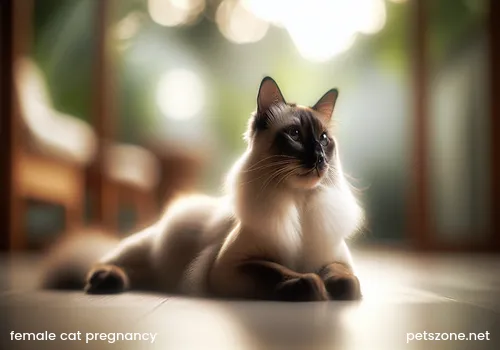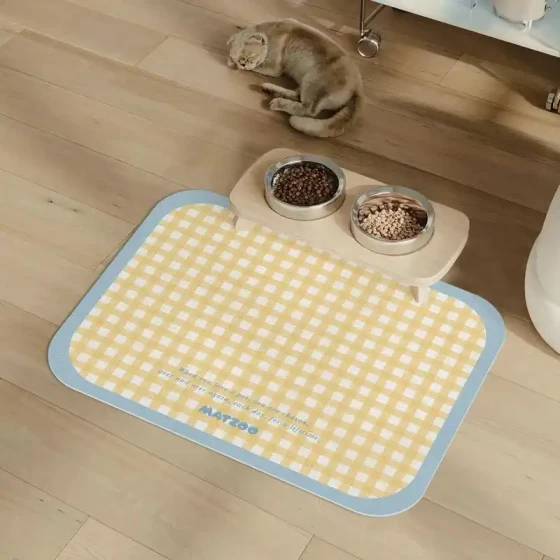Most Obvious Signs of a Female Cat Pregnant for 10 Days_Early Pregnancy Symptom Recognition Guide
At 10 days of pregnancy, a female cat usually does not have particularly obvious external changes. Possible signs include becoming more clingy or lethargic behaviorally, slightly increased appetite, some cats may have mild swelling of the breasts or a small amount of clear discharge from the vulva, but these are not as easily observed as nipple color changes and abdominal enlargement in later stages. Truly noticeable pregnancy signs generally appear around 2-3 weeks post-mating.

For cat owners who suspect their female cat might be "expecting," the feelings are surely both excited and nervous. Especially around ten to fifteen days, when the cat's body has not changed much yet, it's natural to wonder: is she really pregnant or not? Don’t worry, this will guide you through the possible "clues" during the early pregnancy (especially around 10 days), as well as the more obvious symptoms and ways to judge them, so you can have a clear idea.
“Incubation Period” of Early Pregnancy in Female Cats (Approximately First 10 Days)
Just like early pregnancy reactions in humans are not obvious, for female cats in the first few days, even up to about 10 days of pregnancy, there usually aren’t major external appearances changes. At this stage, the fertilized egg has just completed the crucial process of implantation, and hormone levels in the body start to change quietly, but external symptoms are usually not easy to detect with the naked eye.
However, attentive owners might notice subtle behavioral changes in the cat. For example, some female cats become more clingy than usual, always wanting to snuggle next to you and be affectionate; others may become a bit more "homebound," sleeping longer and being less lively and active than usual, somewhat like "laziness." In addition, some female cats may experience a slight increase in appetite early in pregnancy, since their bodies are preparing to nurture new life. A few cats might even have mild vomiting or decreased appetite, similar to human “morning sickness,” usually lasting only a day or two.
Signs Gradually Appear After 10 Days of Pregnancy
Although symptoms are not obvious at 10 days, as the pregnancy progresses, signs become clearer.
Nipple Changes: “Pinking Up” Is an Important Signal
One of the classic early signs after mating is that the female cat’s nipples change. Typically, around 15-20 days post-mating, or about two to three weeks, the nipples begin to turn pinker, sometimes deepening in color, looking more pronounced than usual, and may slightly swell. This change is especially noticeable in short-haired cats. The fur around the nipples may also gradually become sparse, making the nipples stand out more. This phenomenon is figuratively called “pinking up” in the cat world. It’s important to note that nipples can also enlarge and redden during the heat cycle, but this usually accompanies other heat behaviors, while pregnant cats stop going into heat after successful conception.
Appetite and Weight Changes: Eating Well Is a Blessing?
Pregnant female cats usually have increased appetite, sometimes reaching two to three times their normal intake. This is the body storing energy for fetal development. Along with increased appetite, the cat’s weight gradually rises, potentially gaining about 1 to 2 kilograms throughout pregnancy.
Abdominal Changes: Belly Begins to “Show”
At around 3-5 weeks of pregnancy, near one month, the female cat’s abdomen begins to swell, sometimes appearing saggy from the side, much like the human term “showing.” Around 50 days pregnant, abdominal swelling becomes more obvious. However, abdominal enlargement can sometimes be caused by other health issues such as ascites or pyometra, so if the cat’s belly is abnormally enlarged, a veterinarian should check it.
Behavior and Personality Changes: Early Maternal Instincts
Besides physical changes, pregnant female cats may also experience behavioral and personality changes. Some cats become gentler and more affectionate, liking to stay close to their owner and seeking more attention and petting. Others may become more cautious or even anxious, searching for quiet, hidden places to rest and preparing for the upcoming delivery. This nesting behavior usually becomes more obvious during the late pregnancy stage (one to ten days before birth).
How to Scientifically Confirm If a Female Cat Is Pregnant?
While observing the above signs is important, the most reliable method is to take the cat to see a veterinarian. The vet can perform professional examinations to accurately determine if the cat is pregnant and assess the fetus’s condition.
Palpation
An experienced vet can, in early pregnancy (about 25-30 days), gently palpate the cat’s abdomen to feel for embryos, which may feel like small ball-like objects. However, this method requires professional skill, and ordinary owners should not press on the cat’s abdomen casually to avoid injury.
Ultrasound Examination
Ultrasound is a very effective method to confirm pregnancy in cats, usually able to detect fetal heartbeat around 20 days post-mating, confirming pregnancy. Ultrasound can also assess fetal health.
X-ray Examination
X-ray is generally performed in the late pregnancy period (about 40-50 days), since by then fetal bones have calcified and formed, allowing clear visualization of the number of fetuses on the X-ray, helping estimate litter size and prepare for delivery.
Blood Test
Blood tests can detect specific hormone levels in the female cat’s body, assisting in determining pregnancy.
False Pregnancy: A Disappointed Hope?
Sometimes female cats may show pregnancy-like symptoms such as swollen breasts, abdominal enlargement, or behavioral changes, but are not actually pregnant. This is called “false pregnancy” or pseudopregnancy. This condition is usually caused by hormonal imbalance, and symptoms typically fade after 30-40 days. If unsure whether it is a true or false pregnancy, veterinary examination is the most accurate method.
Frequently Asked Questions
-
How long is a female cat’s pregnancy?
The gestation period of a female cat is usually about 63-67 days, roughly around two months, ranging from 58 to 72 days. -
Will a female cat go into heat after becoming pregnant?
A successfully impregnated female cat generally stops going into heat. However, if mating occurs early in the heat cycle and conception is successful, the cat may still show some heat signs until that heat period ends. -
Should pregnant cats be given special nutritional supplements?
Yes, pregnant cats need higher quality and more balanced nutrition, especially ensuring adequate protein and calories. Feeding kitten food can be considered. But be careful not to overfeed to avoid obesity.
Final Thoughts
Observing whether a female cat is pregnant requires patience and care. Early signs may not be obvious, but as time goes by, changes in body and behavior become clearer. If you suspect your cat is pregnant, promptly take her to the vet for professional examination. This not only confirms pregnancy but also provides expert prenatal care advice to ensure the health and safety of the mother cat and her future kittens. After all, "scientific pet care" is the key; we must not take the "lifelong event" of cat pregnancy lightly!



